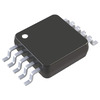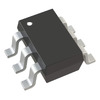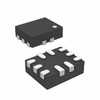Manufacturer Part Number
ADG836YRMZ
Manufacturer
Analog Devices
Introduction
The ADG836YRMZ is a dual single-pole double-throw (SPDT) switch from Analog Devices, designed for precision signal routing applications.
Product Features and Performance
Dual 2:1 multiplexer/demultiplexer configuration
On-State Resistance (Max): 650mOhm
Channel-to-Channel Matching (ΔRon): 40mOhm
Supply Voltage Range: 1.65V to 3.6V
Fast Switching Time: Ton (Max) 26ns, Toff (Max) 7ns
High -3db Bandwidth: 57MHz
Low Charge Injection: 40pC
Channel Capacitance (CS(off), CD(off)): 25pF
Low Current Leakage: 200pA (Typ)
Excellent Crosstalk Performance: -90dB @ 100kHz
Product Advantages
Precision signal handling due to low on-state resistance and channel-to-channel matching
Suitable for battery-powered applications with its low-voltage operation
Quick responsiveness achieved through fast switching times
Minimal signal distortion thanks to low charge injection and channel capacitance
Ensures signal integrity with outstanding crosstalk isolation
Key Technical Parameters
Number of Circuits: 2
Voltage Supply, Single (V+): 1.65V ~ 3.6V
Switch Time (Ton, Toff) (Max): 26ns, 7ns
-3db Bandwidth: 57MHz
Operating Temperature: -40°C ~ 125°C (TA)
Quality and Safety Features
Manufactured by Analog Devices, known for high-quality and reliable components
Operates reliably over a wide temperature range (-40°C to 125°C)
Compatibility
Surface Mount Technology (SMT) for easy PCB integration
Packaged in a 10-MSOP format for compact placement
Application Areas
Precision data acquisition systems
Battery-powered devices
Audio and video signal routing
Communication systems
Product Lifecycle
Product Status: Active
No announced discontinuation, ensuring long-term availability
Several Key Reasons to Choose This Product
High-performance signal routing with minimal distortion
Low power consumption suitable for portable devices
Fast switching speeds enhance system responsiveness
Robust design ensures reliability in extreme conditions
Analog Devices' reputation for quality and longevity in components


 ADG839YKSZ-500RL7Analog Devices Inc.IC SWITCH SPDTX1 500MOHM SC70-6
ADG839YKSZ-500RL7Analog Devices Inc.IC SWITCH SPDTX1 500MOHM SC70-6 ADG836YCPZADI (Analog Devices, Inc.)
ADG836YCPZADI (Analog Devices, Inc.) ADG836YCPZ-REEL7Analog Devices Inc.IC SWITCH SPDTX2 650MOHM 12LFCSP
ADG836YCPZ-REEL7Analog Devices Inc.IC SWITCH SPDTX2 650MOHM 12LFCSP ADG824BCPZ-REEL7Analog Devices Inc.IC SWITCH SPDTX2 800MOHM 10LFCSP
ADG824BCPZ-REEL7Analog Devices Inc.IC SWITCH SPDTX2 800MOHM 10LFCSP